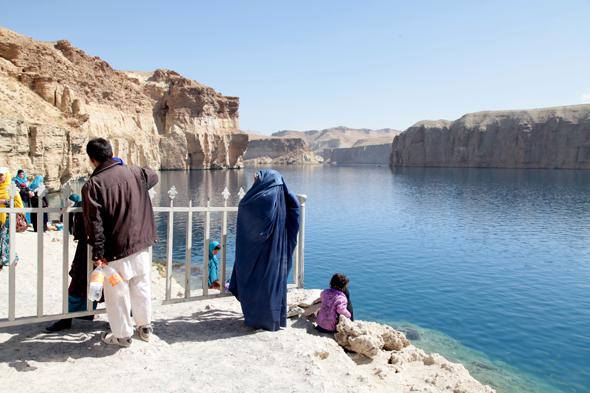Each Friday, Roads & Kingdoms and Slate publish a new dispatch from around the globe. For more foreign correspondence mixed with food, war, travel, and photography, visit their online magazine or follow @roadskingdoms on Twitter.
BAMIYAN, Afghanistan—Wedged between the Hindu Kush and Koh-i-Baba mountain ranges in the central highlands of Afghanistan, Bamiyan is a sleepy, unimposing town. In the afternoon, when the sun throws a golden glow on the cliffs, the men return from the fields to the whiff of kebab smoke on the main street. Boys riding cheap Iranian motorbikes kick up the dust that settles over roadside stalls, coating vegetables in grit.
Today, the people of Bamiyan have something most Afghans envy: peace. And that is a key component in Mohammad Reza Ibrahim’s plan.
In fake black Ray-Bans and a Marlboro straw hat, Ibrahim, like most men under 40 in this town, keeps his cheeks clean-shaven. His English is effortless and his friendliness unfailing. And it’s fair to say he doesn’t shy away from a challenge.
As manager of Bamiyan’s tourism association, Ibrahim is the brains and muscle behind a push to convince foreigners to visit a town made internationally famous by one of the worst acts of cultural terrorism in recent history. Having enjoyed years of relative stability, Bamiyan wants to open up its cultural heritage to intrepid travelers curious to see more of the country than war.
“Bamiyan has a great potential for tourism,” Ibrahim says. “Bamiyan is different from other provinces in Afghanistan. When you come to Bamiyan, you feel safe and secure.”
Ibrahim can point to enough attractions in Bamiyan to put your average tourist trap to shame. Yes, it is known for the two giant Buddha statues, blown up during the reign of the Taliban, but Bamiyan is also home to magnificent ruin cities, caves featuring some of the oldest oil paintings in the world, and Afghanistan’s first national park. During winter, when the temperature drops far below zero and most hotels close because of frozen pipes, Bamiyan even boasts the country’s only ski slope (no lift or après ski just yet).
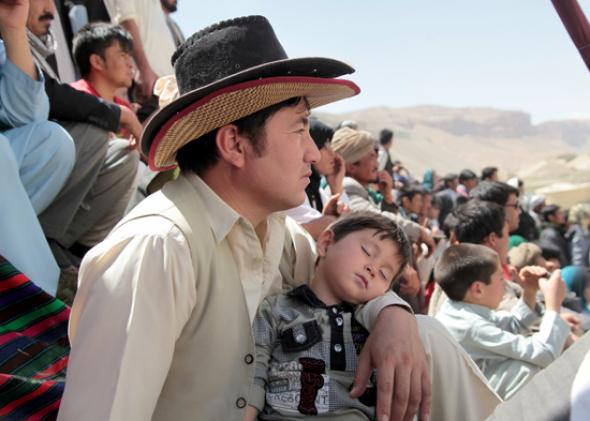
Photo by Sune Engel Rasmussen
Ibrahim has condensed all of this into an effective sales pitch that he feeds me several times over the two days we spend together. But I’m a journalist, and I’m already here. Luring tourists from outside the country is a different matter entirely.
* * *
In Afghanistan, where suicide bombings are still depressingly common, you tend to avoid crowds. But I have no choice. Snapping away with my camera, I hear hollering men approaching from behind. They close in, submersing me in the damp heat and sweat of soaked, sunbaked bodies. Feet stomp my toes and elbows jab my ribs.
The reason for the tumult is a wrestling match that just got intense. In a dusty valley in Band-e Amir national park, Bamiyan’s best (and heaviest) wrestler is locking foreheads with Ali Ahmad, a scrawny looking dude from a neighboring village. Ali Ahmad has a firm grip on the back of the chubby guy’s shorts. Ibrahim tiptoes around the wrestlers with a whistle around his neck to enforce fair play.
After five minutes of heavy breathing in this position, Ali Ahmad suddenly takes a quick step to the left. Before the big guy can gather his balance, Ali Ahmad thrusts his shoulder into the guy’s armpit and trips him, throwing him to the ground so they both disappear in a cloud of dust. The crowd surges forward, sweeps Ali Ahmad off the ground and carries him away on a clapping, caterwauling mass of hands.
When I visit Bamiyan, the sixth Silk Road Festival is in full swing. The festival is an annual celebration of the local Hazara culture, featuring a wobbly but entertaining mix of concerts, theater, poetry, stand-up comedy, handicraft exhibitions, and traditional games—including wrestling.
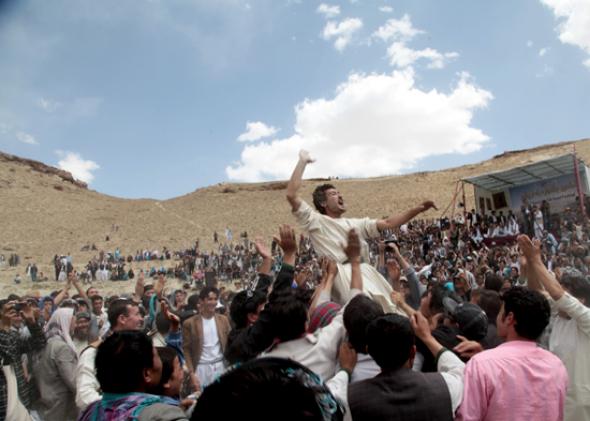
Photo by Sune Engel Rasmussen
The Hazara people make up between 10 and 15 percent of the Afghan population and have, for five centuries, faced varying levels of oppression from the country’s leaders. Believed to be descendants of the Mongols, they live primarily in the central highlands of Afghanistan, though centuries of displacement have pushed many of them to Pakistan and Iran. A large Hazara population has also settled in Kabul where they make up around one-quarter of the population.
Since the ouster in 2001 of the Taliban who drove Hazaras out of the area, many of them have returned to Bamiyan. Afghanistan’s outgoing president, Hamid Karzai, has been tolerant of minorities, so while Afghan Hazaras still face discrimination, their conditions have undoubtedly improved. Several of Karzai’s ministers as well as one of the candidates for vice president in this year’s election are Hazaras.
The Silk Road festival includes cultural performances by people visiting from other provinces. Fellow Hazaras from the neighboring Daykundi Province perform a traditional dance with sticks, and a dozen Pashtun men show the audience how they dance in Paktia.
The greatest crowd draws, though, are the competitions. Around 2,000 people watch as two teams of 10 face off in a langi competition, a sort of one-legged race where contestants hold one foot behind their back while trying to tussle each other to the ground.
There are few security forces around, a rare sight in Afghanistan. What little security there is seems more occupied with helping Ibrahim keep the two sides of a vein-popping tug-of-war competition in place rather than with any sort of crowd control.
On a stage on a hill overlooking town, Abbas Neshat is plucking a danbur, a traditional two-stringed instrument. He knocks the body of the instrument with his knuckles and strums the strings with four-fingered flicks. The effect is something close to a Spanish guitar.
Baby-faced and with a suave tenor, Neshat is a crowd darling, known for his appearance on Afghan Star, a nationally televised talent show. Men take to their feet and dance around in circles. The Taliban may have wrought havoc on the mountains with their dynamite, but they could not kill the music.
Normally, the mood in Bamiyan is sleepier, and it doesn’t take much to get away from people altogether. Pretty much any road out of Bamiyan leads to open wilderness. From the backseat of Ibrahim’s white Corolla, I see the open valley of Bamiyan narrow as the road going west slices its ways between tall cliffs. After 50 miles westward, Ibrahim leaves the highway and muscles the car down a dirt road leading into Band-e Amir, Afghanistan’s first national park. Reddish tablelands curve smoothly down leather colored mountainsides into dusty valleys where the park spreads out around six deep blue freshwater lakes. The clear water reflects the sun so sharply it burns your face.
Reliable tourism numbers are hard to come by, but according to the Aga Khan Foundation, a humanitarian organization that supports Bamiyan’s tourism endeavors, the number of foreign visitors has dropped over the past decade. In 2005, approximately 4,000 foreigners visited Bamiyan. Since 2009, when security in the country deteriorated, between 400 and 1,000 people have visited annually—a total of 4,300 in five years, primarily Europeans and Americans living and working in Kabul. The South Asia Association for Regional Corporation recently named Bamiyan its Cultural Capital for 2015, prompting hope that tourism figures will jump next year.
Despite its other attractions, Bamiyan’s claim to fame is two holes in the wall of a mountain. Here, in the sixth century, Buddhists cleaved two giant statues from the sandstone cliff. They called the tallest Buddha, which towered 53 meters over the valley, the King of Bamiyan. The statues withstood invasions from some of history’s most ruthless conquerors, including Genghis Khan, who besieged Bamiyan in 1221 after his grandson was killed here.
But they did not survive the Taliban. In 2001, as part of leader Mullah Omar’s war on idolatry, Taliban pummeled the Buddhas with dynamite and rockets, until the stoic statues crumbled to gravel.
The Afghan government is keen to rebuild at least the smallest of the Buddhas—as a symbol of Taliban’s defeat. That is unlikely to happen. UNESCO, which put the site on its World Heritage List, insists that too much of the original material from the statues has been lost. Attempts to rebuild the original pieces would be reproduction rather than true reconstruction. “The void is the true sculpture,” a UNESCO consultant said in 2012.
However, that hasn’t stopped some people from trying. Tasked with building a plateau to support the wall of the smallest niche, a team of German conservationists in 2013 built two brick busts shaped like the lower part of two legs fixed on feet. UNESCO raged that the move was “bordering on criminal” and had caused “irreversible damage.” No one has touched the niches since.
* * *
The hardest part of convincing people that coming to Bamiyan is a good idea may be figuring out a way to get them here.
The neighboring provinces are extremely volatile and getting worse. The main highway from Kabul, leading through Wardak Province, a long-time Taliban stronghold, is nicknamed “Death Road” by locals, many of whom prefer to not leave their own province at all.
As international troops prepare to scale down next year, the Taliban has been testing the resilience of the Afghan security forces. Militants have closed in on important districts in the east and south. Crime is on the rise, even in cities that have traditionally been safe.
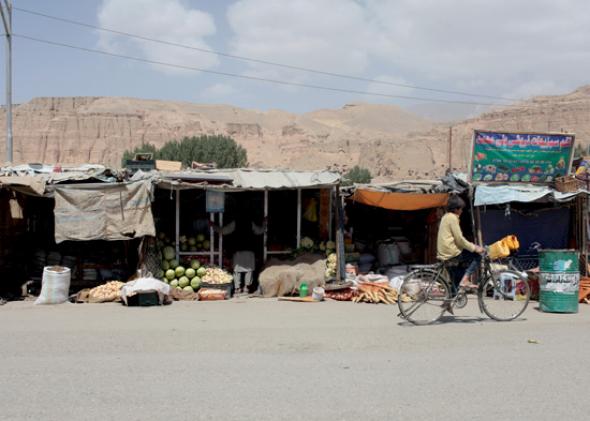
Photo by Sune Engel Rasmussen
“Of course, of course, Bamiyan is a part of Afghanistan. The overall security situation will impact the security in Bamiyan,” Ibrahim says when I push him on security concerns. But he points out that a private airline last year began flying three times a week from Kabul to Bamiyan.
“We need to link Bamiyan to the outside of Afghanistan. Maybe with direct flights from Bamiyan to international airports, we can solve the problem of security in Afghanistan,” he says.
Once they arrive in Bamiyan, travelers also face infrastructure challenges. Cellphone reception evaporates 10 minutes outside of town, which will surely deter many from traveling in the surrounding area. Many roads in the province have been paved, but going east, the rugged way to the Red City, or Shahr-e Zohak, is less than 10 miles long but takes half an hour to drive.
The Red City was built as a fortress 1,500 years ago at the confluence of two rivers, to a backdrop of tan mountains and jagged copper ridges stretching through the landscape like giant lizards’ tails. The fortress was trashed by the Iranian army in the 14th century, and later used by the Taliban as a hideout during the 2001 invasion. Mounds of bullet casings still litter the site.
Three decades of war have put its mark on the landscape. Through the years, insurgents on all sides have scattered mines around the province. In March, an old explosive killed seven children as they were playing. Rain had carried the mine down from the mountains and washed it onto a field a few meters from the main road.
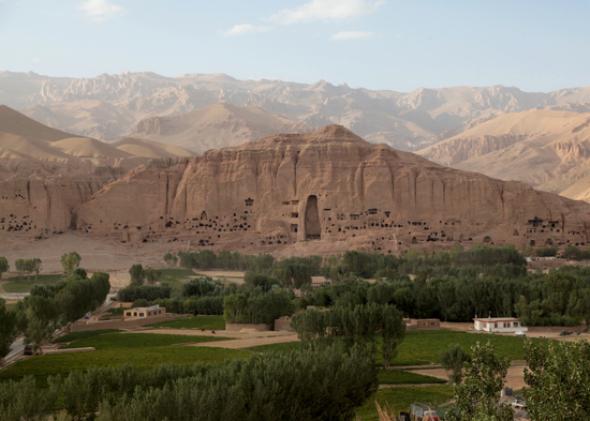
Photo by Sune Engel Rasmussen
* * *
Bamiyan has much in common with Iraqi Kurdistan. Both the Kurds and the Hazaras are religious minorities who have found their own refuge in a country torn by war. Both of them also often claim to be more open-minded than their countrymen. In the case of Bamiyan, that includes a certain measure of gender equality.
“Bamiyan is one of the best places in Afghanistan to be a young woman,” Fatima Nazeri, a 16-year-old female student, tells me. “Here it is safe for women to study and go to university.”
To be fair, Bamiyan is not the only place where Afghan men encourage women to study. But the presence of women in public life here is unusual. In 2005, the first female governor in Afghanistan’s history, Habiba Sarabi, was appointed to Bamiyan. Earlier this year, the town organized its first running and cycling races, both with separate competitions for women.
In the middle of the bazaar, a group of women, supported by a Western NGO, have started a women’s café (no access for unaccompanied men). Even the annual skiing competition is open for women, as long as they observe Islamic dress code and wear helmets.
Bamiyan’s push for tourism began in earnest in 2008 with a $2 million donation from New Zealand’s government for ecotourism programs. The grant lasted four years, after which the Norwegian embassy stepped up with another $600,000.
The money also works to modernize Bamiyan’s dormant economy, Ibrahim says. Poverty in the province is rampant. Even with 80 percent of its income deriving from agriculture, Bamiyan still needs to import half of its food. More than two-thirds of the province’s population lives under $25 a month. Foreign aid is primarily funneled to southern and eastern provinces that see more fighting.
“Tourism would be a good alternative to this traditional way of livelihood,” Ibrahim argues.
Later this year, when Bamiyan’s sixth tourist hotel opens its doors, the town will be able to host 300 sleeping guests. One of the hotels, Silk Road, is owned by a Japanese chef and her Afghan husband, and is the only establishment in town that serves an alternative to the standard fare of grilled kebab with fresh bread. When I visited, the menu was sushi made with canned tuna.
Next year, the first batch of 30 students from the university tourism department, where Ibrahim teaches, will graduate. In three years, 100 freshly hatched tourist guides will be ready to be dispatched, not only across town, but to other provinces as well.
It is unclear whether tourists are ready for Bamiyan. But Bamiyan is ready for them.
